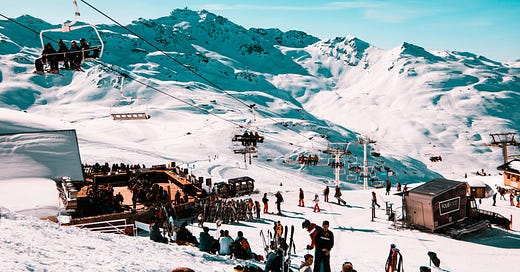Preparing for Your First Ski Trip
Ski season is coming up. Here are my recommendations for people getting started.
Ski season is coming up. Unless you prepare beforehand, you won't be in a state where you can actually do any skiing or snowboarding. Here are my recommendations for people getting started.
Required Gear
Skiing is expensive. You'll need a fair amount of equipment. Fortunately, a lot of this consists of fixed costs. So grab out your credit card and pull up Amazon. Most of the gear can be found pretty easily with a "<item name> snowboarding" query on Amazon. You don't need to be creative; usually, the first result works great.
You probably already have these
Winter jacket: Just a generic winter jacket.
Gloves or mittens: Make these that these are waterproof. The cloth-based gloves aren't waterproof, nor will they do an effective job of keeping your hands warm.
Buy these
Thermals or long johns: These don't have to be skin-tight. Your goal is to wear more layers in order to provide additional insulation.
Long winter socks: These should go up to the calves (at least) and should be higher than your ski shoes/snowboarding boots.
Snow pants: These will be pretty stretchy since you'll be fitting them over your ski shoes/snowboarding boots. So don't be surprised if they feel a bit large at first.
Ski goggles: This one's self-explanatory. They should be large enough to fit over glasses, but I still recommend my myopic friends wear contact lenses.
Helmet: The proper helmets will have a strap in the back to attach your goggles. For the best protection, I recommend getting a helmet that's MIPS certified. They will be a lot more expensive than normal helmets, but I guess you decide how much your brain cells are worth. (Though if you're only going to be on the bunny slopes, it may not be a big deal.)
Gaiter or balaclava: Also known as a "ski mask," these are key for blocking your face from wind and debris. Plus it insulates your head. You may also want one of these if you plan to rob a bank.
[Snowboarding only] Butt pads: When snowboarding, expect to fall on your ass a lot. So I recommend getting some armor to prevent you from hurting your butt. (Unless you're into that kind of stuff.)
[Snowboarding only] Knee pads: In a similar vein, expect to fall forward as well. Your knees will take repeated punishment, so having some armor there is a game-changer.
[Snowboarding only] Wrist guards: Also when falling forward, humans will reflexively put their hands out to "break" the fall. This is the worst thing you can do. If you fall forward, hug yourself and try to land on your forearms. You want to distribute the force over your body. Otherwise, that's how you break your wrists. But in such a case, wrist guards may save you a lot of misery. (Note that I personally don't use wrist guards. They tend not to fit well with gloves.)
Rent these
The renting portion is relatively self-explanatory. If going on a day trip, rent the actual equipment:
Skis, poles, and ski shoes
Snowboard and snowboarding boots
Expect to pay $50-100 to rent the gear for a day. Some resorts may provide a helmet as part of the rental bundle. I'd advise against buying the main equipment for the first few seasons, as you haven't formed a preference for what specific types of skis/snowboards you like.
If you forget to buy some of the recommended items, the resort will likely have them for sale or rent. But be aware that the prices will be marked up a lot. So save your money and do a better job of preparing.
In general, depending on how many days you plan to go to the resort, it may make sense to rent at a local shop, rather than renting from the resort. Pricing will be better, but there will also be an expectation of a longer-term rental. You'll have to do the math yourself for those situations. For day trips, don't waste your time; just rent from the resort.
Other Considerations
Resort logistics
Ski resorts local to the DMV area include Liberty and Whitetail. These can be around an hour's drive and easily fit into a day trip.
Expect to pay around $200 per day. That's around $100 for a day pass and $100 for rental equipment. You may incur other expenses throughout the day, such as paying for food and lessons.
If you end up going for multiple days in a season, it's far more economical to buy a season pass. The last time I did the math, the break-even point was around 10 trips or so.
I recommend setting up all of these logistics as early as possible since walk-in passes/rentals aren't guaranteed (and prices go up over time).
Skiing vs snowboarding
Do you go skiing or snowboarding? They all have their pros and cons. Though if you've done neither and only plan to spend one day, I recommend you go skiing.
Before skiing or snowboarding, consider watching some tutorial videos (skiing, snowboarding) so you aren't taken completely by surprise. You can also take lessons, I've found that trial-and-error after watching tutorials tends to be more effective.
EDIT: I found a better tutorial for skiing. Watch this one instead.
Additional supplies
Bringing your own food is optional since there are cafes at the resort. Though it's not a bad idea to have snacks and water in the car.
Consider bringing sunscreen. Though it's not the end of the world if you're covered up.
Ski helmets will have ear flaps to insulate your ears, so it's possible to safely wear Airpods and listen to music while going down the slopes. But if you're reading this blog post, maybe you should focus on staying alive instead.





